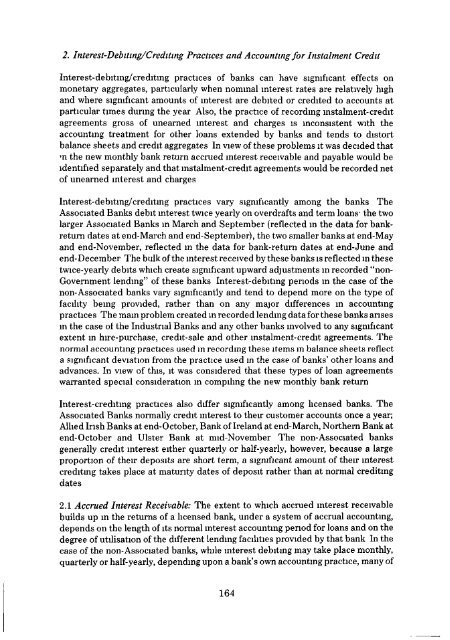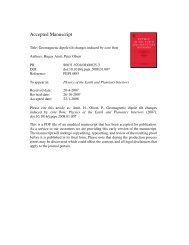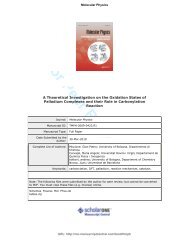parti: objectives and features of the new reporting system 159 - TARA
parti: objectives and features of the new reporting system 159 - TARA
parti: objectives and features of the new reporting system 159 - TARA
Create successful ePaper yourself
Turn your PDF publications into a flip-book with our unique Google optimized e-Paper software.
2. Interest-Debiting/'Crediting Practices <strong>and</strong> Accounting for Instalment Credit<br />
Interest-debitmg/creditmg practices <strong>of</strong> banks can have significant effects on<br />
monetary aggregates, <strong>parti</strong>cularly when nominal interest rates are relatively high<br />
<strong>and</strong> where significant amounts <strong>of</strong> interest are debited or credited to accounts at<br />
<strong>parti</strong>cular times during <strong>the</strong> year Also, <strong>the</strong> practice <strong>of</strong> recording instalment-credit<br />
agreements gross <strong>of</strong> unearned interest <strong>and</strong> charges is inconsistent with <strong>the</strong><br />
accounting treatment for o<strong>the</strong>r loans extended by banks <strong>and</strong> tends to distort<br />
balance sheets <strong>and</strong> credit aggregates In view <strong>of</strong> <strong>the</strong>se problems it was decided that<br />
m <strong>the</strong> <strong>new</strong> monthly bank return accrued interest receivable <strong>and</strong> payable would be<br />
identified separately <strong>and</strong> that instalment-credit agreements would be recorded net<br />
<strong>of</strong> unearned interest <strong>and</strong> charges<br />
Interest-debitmg/creditmg practices vary significantly among <strong>the</strong> banks The<br />
Associated Banks debit interest twice yearly on overdrafts <strong>and</strong> term loans* <strong>the</strong> two<br />
larger Associated Banks in March <strong>and</strong> September (reflected ID <strong>the</strong> data for bankreturn<br />
dates at end-March <strong>and</strong> end-September), <strong>the</strong> two smaller banks at end-May<br />
<strong>and</strong> end-November, reflected m <strong>the</strong> data for bank-return dates at end-June <strong>and</strong><br />
end-December The bulk <strong>of</strong> <strong>the</strong> interest received by <strong>the</strong>se banks is reflected in <strong>the</strong>se<br />
twice-yearly debits which create significant upward adjustments m recorded "non-<br />
Government lending" <strong>of</strong> <strong>the</strong>se banks Interest-debiting periods in <strong>the</strong> case <strong>of</strong> <strong>the</strong><br />
non-Associated banks vary significantly <strong>and</strong> tend to depend more on <strong>the</strong> type <strong>of</strong><br />
facility being provided, ra<strong>the</strong>r than on any major differences in accounting<br />
practices The mam problem created in recorded lending data for <strong>the</strong>se banks arises<br />
in <strong>the</strong> case <strong>of</strong> <strong>the</strong> Industrial Banks <strong>and</strong> any o<strong>the</strong>r banks involved to any significant<br />
extent in hire-purchase, credit-sale <strong>and</strong> o<strong>the</strong>r instalment-credit agreements. The<br />
normal accounting practices used in recording <strong>the</strong>se items in balance sheets reflect<br />
a significant deviation from <strong>the</strong> practice used in <strong>the</strong> case <strong>of</strong> banks' o<strong>the</strong>r loans <strong>and</strong><br />
advances. In view <strong>of</strong> this, it was considered that <strong>the</strong>se types <strong>of</strong> loan agreements<br />
warranted special consideration in compiling <strong>the</strong> <strong>new</strong> monthly bank return<br />
Interest-crediting practices also differ significantly among licensed banks. The<br />
Associated Banks normally credit interest to <strong>the</strong>ir customer accounts once a year;<br />
Allied Irish Banks at end-October, Bank <strong>of</strong> Irel<strong>and</strong> at end-March, Nor<strong>the</strong>rn Bank at<br />
end-October <strong>and</strong> Ulster Bank at mid-November The non-Associated banks<br />
generally credit interest ei<strong>the</strong>r quarterly or half-yearly, however, because a large<br />
proportion <strong>of</strong> <strong>the</strong>ir deposits are short term, a significant amount <strong>of</strong> <strong>the</strong>ir interest<br />
crediting takes place at maturity dates <strong>of</strong> deposit ra<strong>the</strong>r than at normal crediting<br />
dates<br />
2.1 Accrued Interest Receivable: The extent to which accrued interest receivable<br />
builds up in <strong>the</strong> returns <strong>of</strong> a licensed bank, under a <strong>system</strong> <strong>of</strong> accrual accounting,<br />
depends on <strong>the</strong> length <strong>of</strong> its normal interest accounting period for loans <strong>and</strong> on <strong>the</strong><br />
degree <strong>of</strong> utilisation <strong>of</strong> <strong>the</strong> different lending facilities provided by that bank In <strong>the</strong><br />
case <strong>of</strong> <strong>the</strong> non-Associated banks, while interest debiting may take place monthly,<br />
quarterly or half-yearly, depending upon a bank's own accounting practice, many <strong>of</strong><br />
164
















